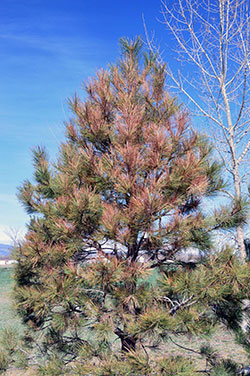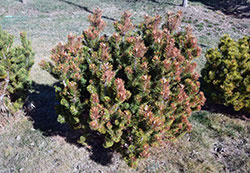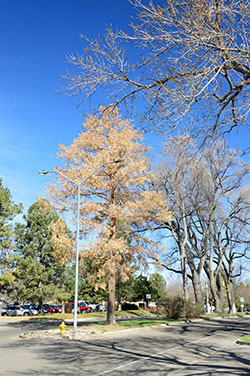Bill Ciesla
Colorado State University Extension Master Gardener in Larimer County
April 5, 2015

During the past winter, the needles of many pines growing in Fort Collins and surrounding communities have turned a sickly red-brown color. While several factors may be involved, a likely cause of the discoloration is a condition known as winter drying. In addition, many pines were injured during the sudden temperature drop in November 2014. The temperature dropped more than 50 degrees in a 24 hour period. Trees were starting their winter hardening process, but our weather leading to this event was fairly mild. Injury appears to be most prominent on exposed sides of the tree.
Each winter, drying of pines and other conifers, such as spruce and juniper, is a common injury caused by weather. Damage typically occurs during late winter to early spring. It is caused by warm, dry winds during times when the tree’s root system is still frozen. Conifers transpire through their needle during winter resulting in some water loss. Periods of warm, dry winds accelerate the water loss, which the frozen roots are unable to replenish. This causes the needles to dry and become discolored. Also, with winter drying, often the bases of the needles and at least some entire needles remain green.
In many cases, the damage is minor and, with the exception of loss of some needles, trees recover. More severe damage can result in death of branch tips or entire branches. Often, the side of the tree that faces the prevailing winds, usually out of the west, is most susceptible to winter drying. The buds on the tips of branches are likely viable and the tree should push new growth.

This spring, the trees most frequently affected by winter drying that I’ve seen in Fort Collins and Loveland are mugo and Austrian pines. An area of particularly conspicuous damage is in relatively recently planted pines immediately north of the Target Super Store on Harmony Road. Four species of pines have been planted here; piñon pine, limber pine, two Colorado natives, and mugo and Austrian pines, both native to Europe. Only the mugo and Austrian pines show symptoms of winter drying.
Our native conifers can also be affected by winter drying, however. Several years ago, large patches of ponderosa pines with red-brown foliage due to winter drying occurred in La Veta Pass in the southern portion of the state. In some areas of the west, winter drying of lodgepole pine can occur in distinct elevation zones, resulting in bands of red-brown trees on the sides of mountains, a condition often referred to as red belt.
There is little that can be done to control the weather, but some measures can be taken to reduce the impact of winter drying. These include:
- Plant trees properly according to the latest guidelines; refer to CSU Extension Garden Notes #636.
- Select trees that are hardy and well adapted to the local climate.
- Where possible, plant trees in well-drained soils.
- Plant where trees are protected from winds.
- Water young trees regularly in fall and winter when the soil is not frozen.
- Mulch around trees to prevent deep freezing; keep much off the top of the root ball of newly planted trees and 6” away from the trunk of established trees.

Winter drying isn’t the only cause of red-brown foliage discoloration of pine needles. Another cause is the all too familiar mountain pine beetle, which, since 1996, has killed large numbers of pines over 3.4 million acres of Colorado’s forests. In addition pines, especially Scotch pine, have been attacked and killed in many urban communities. While this massive outbreak has declined in recent years, primarily because most of the susceptible pines have been killed, a low level of activity is continuing. I’ve seen a small number of Scotch pines in Fort Collins dying from beetle attack this spring. Mountain pine beetle attacks are easily distinguished from winter drying by the presence of pitch tubes and/or red-brown boring dust on the boles of trees. With bark beetle attacks, the entire needle is discolored.
All photos by author Bill Ciesla.
The author has received training through Colorado State University Extension’s Master Gardener program and is a Master Gardener volunteer for Larimer County.
——————-
Larimer County is a county-based outreach of Colorado State University Extension providing information you can trust to deal with current issues in agriculture, horticulture, nutrition and food safety, 4-H, small acreage, money management and parenting. For more information about CSU Extension in Larimer County, call (970) 498-6000 or visit www.larimer.org/ext
——————-
Looking for additional gardening information? Check out the CSU Extension Horticulture Agent blog at www.csuhort.blogspot.com for timely updates about gardening around the state.
——————-
Visit PlantTalk Colorado ™ for fast answers to your gardening questions! www.planttalk.org PlantTalk is a cooperation between Colorado State University Extension, GreenCo and Denver Botanic Gardens.





